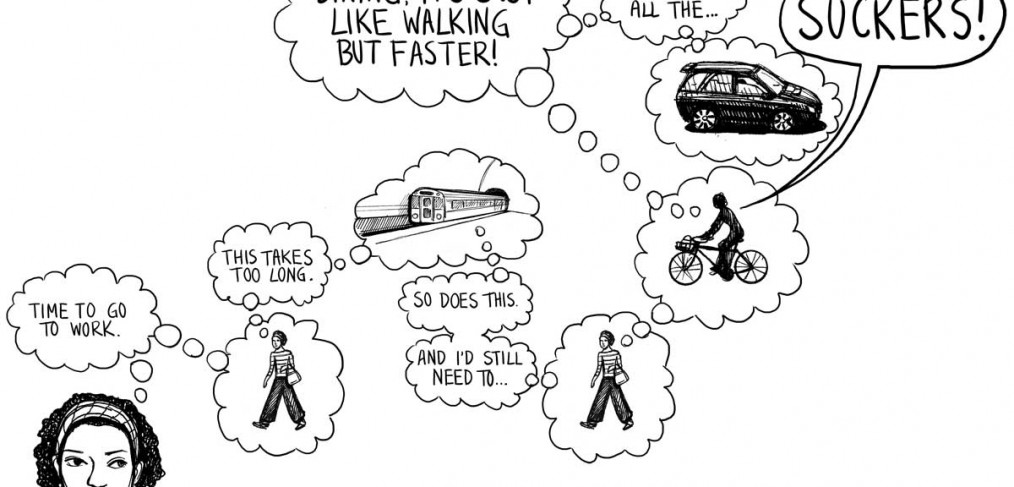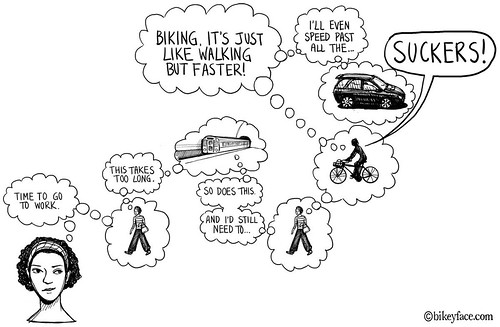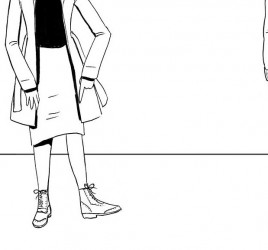
Jaybikers
The other day I was waiting at a red light while a flood cyclists passed by me in every direction. It was a particularly long red, and car traffic was lower than normal. And I’m glad there has been such and increase in biking. However I witnessed several close calls because no one was operating by the same set of rules:
It seemed their main concern was to get from A to B in the shortest, quickest way possible. But it got me thinking about the mindset. There is vehicular cycling, and then there is a more pedestrian approach…
However if you’re just out to get places as fast as possible and not willing to rest on a red, you may just be on a collision course. Stop at a red light sometime and watch what almost happens.






Wow this is really cool!
I thought that this kind of silly cycling is popular in just my country (Czech Republic in the middle of Europe). But seems that it’s worldwide illness?!
Two of them maked me laugh – lycra cool enough and the flying one :-DDD
Seriuosly I see those kinds at my daily commute.
Anyway thank you! Love your job. Pretty nice. Wish I can comment my experiences in the same way you did …
I recognize this situation. Here there are lots of cycling clubs who purely go for speed. Thinking everybody will / must give them right of way. They give cyclist a bad reputation if you ask me.
My attitude: there are laws and rules of the road, and integrated cycling techniques that take advantage of those road rules to make cycling very simple and very safe. It’s not all that burdensome to learn the law and follow these rules and guidelines – and doing so could save one’s life.
I’ve been cycling for 40 years and over 20,000 miles, and in all that time and distance I’ve never once had a crash on the road. That doesn’t happen by chance. It happens through cycling visibly, predictably and carefully, and using the rules that all road users are familiar with.
I’ve been road cycling for 3 years and over 25,000 miles, I ride both ways. If you don’t crash on the road, then you’re probably in a better place to cycle than me. There are times in which I have been forced to blow stop signs because some guy in a massive 4×4 is chasing me yelling “SPANDEX FAG” Really loudly and trying to run me over. I’m in Orange County, CA. This place rocks.
By the way, the cyclist who’s ‘following the law exactly’ is not. He’s too close to the curb. The law in almost every state expects cyclists to take the lane on narrow lanes like the one in the cartoon, to avoid close passes and to remove the threat of right hooks. If that were a real truck, that cyclist would most likely be in the truck driver’s blind spot and would be in danger of being crushed if the driver chose to turn right. On a multi-lane roadway, a cyclist following the law exactly would have been in a position in the middle of the right hand lane.
Ian Brett Cooper, I am glad you pointed that out, because I would definitely pull way out of that driver’s blind spot, but in Mass, he’s not breaking the law. Mass bike law is pretty short of actual content. In Mass, the laws pertaining to cycling are all in one short series of sections – MGL ch. 85, sec. 11B-11E. Two of those sections deal with helmets, one deals with fines for violations, and only one – sec. 11B – deals with actual traffic laws. http://www.malegislature.gov/Laws/GeneralLaws/PartI/TitleXIV/Chapter85/Section11B
The law is skimpy; basically, it says bikes have to follow standard vehicular traffic laws, except that bikes “may” (not must) travel on the right of traffic. You must signal, and you may (though most people don’t know this) ride on sidewalks outside of a “business district” (not defined anywhere) unless it is otherwise marked, and if you are doing so, you have to give ROW to peds and signal when passing them, etc. The rest of the section discusses when you can ride in a pair versus single file, stuff to do with baby seats and other bike passengers, stuff about how to park your bike, not carrying stuff without a basket or rack, not holding on to a car and getting pulled, rules about lights and reflectors, rules about brakes, and stuff about accident reporting.
Basically, the least useful bike law ever. That is literally all there is. I would like to see MassBike do more lobbying for a real, substantive bike law that takes into account what is safest for cyclists, pedestrians, and cars, and recognizes that bikes are not just itty bitty cars, nor are they just fast pedestrians, and so a specific law tailored to bikes is needed. Which reminds me to email them.
@ Jen T: You’re right – he’s not technically breaking the law. Not the letter of the law. But in my view, he’s breaking the spirit of the law, which aims to keep road users safe.
As you rightly point out, in MA, the law has no provision requiring cyclists to ride farther right. And this is what I was referring to with my assertion that he wasn’t riding according to the law. You do not have to ride far right in Mass.
As for the idea that MA law is not useful, I completely disagree. The fact that MA law for cyclists is the same as for other vehicle operators makes it the most cyclist-friendly in the country (see http://ianbrettcooper.blogspot.com/2012/01/invictus.html ). Massachusetts and Indiana are the only two states in the union that don’t have any language in the law requiring cyclists to take up a particular position in the road. This allows cyclists themselves (not government bureaucrats who usually do not cycle) to decide what road position is safest.
Trust me, as a cyclist who used to ride in Somerville and Wakefield, MA, and who now rides in Maryland, you folks in Massachusetts have by far the best cycling laws, because the law does not discriminate.
@ Jen T: MassBike has been active over the past several years. There is no longer an “as far to the right as practicable” law – making use of the full lane legal. Bicyclists are no longer required to ride single file. We may operate our bicycle (defined as a vehicle) on any street, road, way, etc., except for limited access highways which are marked to prohibit bicyclists.
Each municipality is required to define their business district. Thus it cannot be defined in the state law.
In general, to frame the discussion as a matter of “cars” and “bicycles” is not useful. [Right now my car and my bicycle are both doing what those vehicles do when there is no driver pushing on the pedals: nothing at all. They are just sitting there.] If the discussion is framed as a matter of “drivers” who are expected to follow the rules of the road and the laws (no matter their vehicle), the discussion becomes simpler and more useful.
I find myself puzzled by your comment “the least useful bike law ever”. Would you please give examples of the things you would like to see included? [This is an honest request, not a challenge.]
[As you may guess from my e-mail address, I am a cycling instructor certified by the League of American Bicyclists.]
Hi Ralph! No, I know, I didn’t mean that to come off sounding so critical, I was still drinking my coffee. I appreciate all of MassBike’s efforts, and I have carefully followed all the changes in the law. I would just love to see a push to make a big a change – I know starting with smaller changes to those obviously problematic laws was the way to go, but there still needs to be a major overhaul, and I feel like there is finally some momentum to push for it!
Re: business districts, that phrase appears in many bike laws, and I get that it is defined by the municipality, but it’s a pretty unhelpful designation. Why not just do what some other states have done and always allow riding on sidewalks but REQUIRE yielding to pedestrians, audible signalling to pedestrians, and following the same rules and regs as pedestrians? And then just have municipalities indicate if they prohibit cycling on sidewalks through sigage, a /la Cambridge. That’s what Idaho does (and I am going to come back to their law): http://www.lostrivercycling.org/idcode.html. Then there is no ambiguity – like a right turn on red, it’s allowed if there is no sign prohibiting it.
As far as changes, see the below. Though obviously, one huge problem any state has is informing people (all people) about what the law is. So as much as I would like to see these additions, I understand it might be more worthwhile to focus on informing people about the current law.
I would like the law to explicitly say bikes can take the lane. I mean, obviously a lot of these things I am suggesting are implied under the umbrella of the first sentence of section 11B: “Every person operating a bicycle upon a way, as defined in section one of chapter ninety, shall have the right to use all public ways in the commonwealth except limited access or express state highways where signs specifically prohibiting bicycles have been posted, and shall be subject to the traffic laws and regulations of the commonwealth and the special regulations contained in this section…” And most laws have something about “as far to the right as is practicable.” As a lawyer, I understand why that phrase is there – laws written too specifically are trouble, because they leave no room for exceptions for safety, are hard to follow, etc. But I think a little more detail as to what is practicable and not, and an explicit note that taking the lane if the cyclist intends to turn or if the shoulder is unsafe would be great. That’s why the phrase “including but not limited to” was invented (as in, “a cyclist must ride as far to the right of a lane as is practicable, but may ride near the center of the lane when it is not practicable to ride to the right. Such circumstances may include, but are not limited to…”).
The change I would most like to see is this: I would like the law changed to reflect the fact that stopping my 15-pound bike (or even a 40-pound Hubway, when I am on that instead) is much easier than stopping my car, and I have greater visibility on my bike. To that end, I would like us to follow Idaho (I had thought it was Minnesota above, I was wrong), for the reasons laid out in this article: http://sf.streetsblog.org/2012/07/20/bikes-are-not-cars-why-california-needs-an-idaho-stop-law/. Idaho let’s cyclists treat stop signs as yields, and red lights as stop signs: http://www.lostrivercycling.org/idcode.html (see section 49-720).
Ideally, and this is probably not practicable, I would like there to be a requirement that cars yield (when possible) to a bike that has signaled its intention to merge into the lane, as when having to go around a car parked in a bike lane or to avoid an obstacle or to make a left – basically the equivalent of cars having the yield to pedestrians (or on a lake – the rowboat yields to the canoe yields to the sailboat – the bulkiest, least-likely-to-be-damaged thing should always have the onus to yield). I understand that is probably asking a lot and is a better place for education and not law. And we should be yielding to pedestrians! even when it is annoying! I hate it when people don’t stop for pedestrians.
I totally agree that the discussion should be framed around “drivers” but a car is not a bike is not my two feet.
I noticed that too; never stop curbside at a red light beside traffic that might turn right, especially trucks, which will trail to the inside of the turn and take you out. When going straight, always stop ing the center of the general purpose through lane to wait for the green light. If the lane is wide enough to share side by side with other drivers, or if there is a curbside bike lane, wait until you get to the other side of the intersection before you move to the right again.
Lots of people get hurt by right turning trucks and buses by stopping and waiting curbside at red lights, thinking they are doing the right thing. This happens especially often to women who want to follow what they think are the rules and be good citizens, while many men just run the light rather thay waiting in the right-hook danger zone. But the best lawful approach is to wait for the green light while in a position farther left, in line with other through traffic.
unless I know I can get out front, I never stop immediately to the right of the first car at a light – I typically stop where the second car can see me but slightly behind the first car – it’s safer because I can let the first car do whatever without being in their blind spot, and the second car can see me so they’ll be more likely to let me go before they turn. I ALWAYS stay behind trucks and buses at lights.
for left hand turns (non-turn lanes) I just take the whole lane b/c I don’t want someone passing me on the left or turning with me on my right. If people pull up behind me and honk I just assume they are morons.
also – I hate cyclists who run red lights on trafficky roads – especially if they blow through a line of pedestrians. I secretly want someone to clothesline that self-absorbed jerk when they do that.
Oregon law states that you must ride ‘as far to the right as practically possible’ or something like that. So essentially, it’s up to everyone’s interpretation at the moment what that means, and of course, the person on the bike, and the person in the car behind them may have different ideas as to what is practically safe – not to mention a judge in a courthouse. It’s not illegal to take the full lane, but if you are determined to be ‘impeding the reasonable flow of traffic’ when you potentially could have been (in someone’s eyes) getting out of the way safely, you might still get in trouble. There is a lot of room for interpretation.
In practice, what the law means is determined by a police officer and then finally by the judge in a court. Sadly, police officers and judges tend not to be cyclists, so they are often ignorant regarding what is safe and practicable for a cyclist on the road. This is further complicated by the fact that cycling safety is often unintuitive – what looks safe (i.e. riding in the gutter or on the sidewalk) often isn’t, while what looks dangerous (i.e. riding well away from the curb) is often safest.
This is why cycling advocates are trying to get ‘Far Right’ laws overturned in the 46 states where they exist.
Taking the lane is still an act of courage in Boston (though drivers have become much less road-ragey when I do this in the last couple of years).
I always tell myself that when somebody behind me in a car honks at me when I take the lane I’m just going to slow down to punish them for their lack of patience and respect but I also realize that cars can easily turn into weapons in the hands of a drive at wits end.
Cycling with a smile helps too, though it’s not required by law.